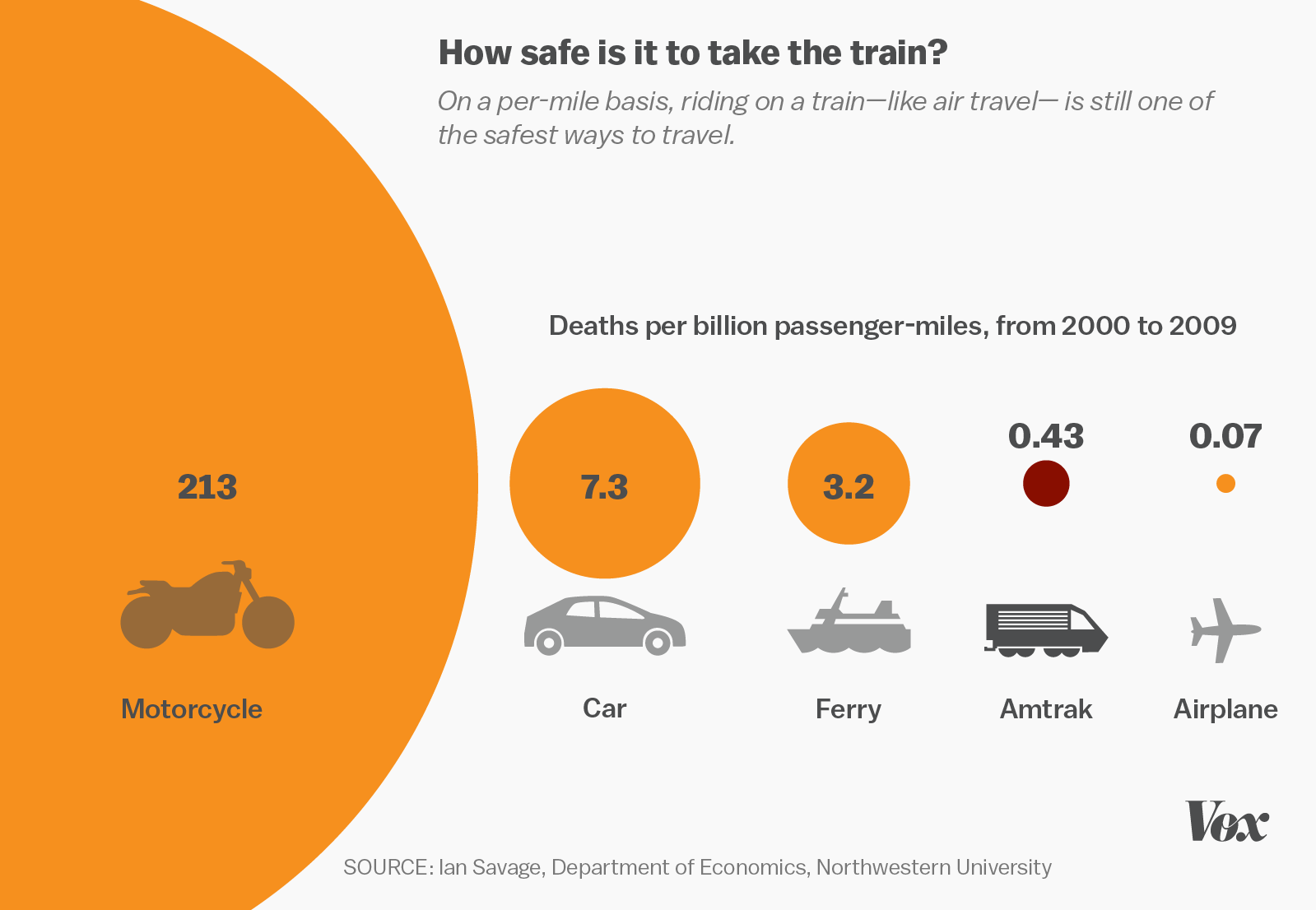It’s an older article, but the point stands!
Bike not listed.
I’m invincible!
Depends on where you ride your bicycle.
In the US, bicycle deaths are at 79 per billion miles src. In the Netherlands, this is 17 per billion miles. src.
Note that the Dutch take much more risk when cycling. It is normal for young kids to cycle to school and sports unsupervised. Bicycle helmets are very rare. Despite that “reckless behavior”, cycling is quite safe here. Having dedicated cycling infrastructure really helps.
Before I make this statement, yeah, I know where I am.
Deaths per billion passenger-miles
All of these fatality rates, for all of these forms of transportation, are vanishingly small. Comparing the rates of one vehicle to another with phrases like “17 times more likely” while ignoring the “billion passenger-miles” scale is misleading.
In order to present these in a more complete way, the odds of dying on each of these vehicles is:
- Motorcycle: 0.000000213
- Car: 0.0000000073
- Ferry: 0.0000000032
- Amtrak: 0.00000000043
- Airplane: 0.00000000007
That is per mile, which is usually not the distance humans limit themselves to in their lives. Assuming you travel a million miles in your life, you do have a 20% chance of dying if exclusively using a motorcycle, which I would consider relevant. The change from car to train already far less so.
Fair and excellent points.
Assuming 20,000 miles traveled per year, it would take 50 years to reach 1,000,000 miles. So let’s lay out the % odds of fatality over 50 years, at 20,000 miles per year, if using each of these means exclusively:
- Motorcycle: 21.3%
- Car: 7.3%
- Ferry 3.2%
- Amtrak: 0.43%
- Airplane: 0.07%
You’re also getting at another important point: it is difficult for people to really comprehend very large or very small numbers. With that in mind, if we divide each of those percentages by 50, we should come up with the odds of dying in a given vehicle per year, again, given a 20,000 mile per year usage and exclusive use of one vehicle type:
- Motorcycle: 0.426%
- Car: 0.146%
- Ferry: 0.064%
- Amtrak: 0.0086%
- Airplane: 0.0014%
Of these, only motorcycle and car are anywhere near significant, and they’re still really unlikely. The remaining three still are small enough to be essentially incomprehenisble. (And who travels 20,000 miles a year on a ferry, anyway?)
Another bit I would like to note is that the comparison posed was between car and train, based on safety. Why was airplane not mentioned? It’s far and away the least likely to kill you.
Of course airplane wasn’t mentioned. Airplanes are not appropriate solutions to many kinds of necessary travel, and airplanes in general have a worse reputation for their environmental effects. Trains are not solutions to many kinds of necessary travel, either, at least not in the current landscape of travel options available to very many people in the United States.
Again, I know exactly where I’m commenting. I definitely think that there should be way more public transportation options available. I think the number of individual-operated vehicle miles can and should be reduced. I think the kinds of individual-operated vehicles should be addressed more sensibly (we don’t get to have the small pickups of the 80s and 90s because of unintended consequences of CAFE standards driving manufacturers to create larger and larger “light” trucks, for example).
Pointing out that “cars are 17 times more likely to kill you than trains!” does not serve the purpose of making a better world through transportation reform.
Trains are not solutions to many kinds of necessary travel, either, at least not in the current landscape of travel options available to very many people in the United States.
That’s kind of the point though. Trying to get folks in the US to support better travel infrastructure. Doesn’t even always have to be trains.
Pointing out that “cars are 17 times more likely to kill you than trains!” does not serve the purpose of making a better world through transportation reform.
Why not? Everything you said honestly made it sound like everything else is a much safer alternative than personal vehicles. Why is that not an argument for better infrastructure and transportation reform? I’ve known people who have died in car accidents. I do not know anyone that’s even been in a train accident let alone killed in one. Your numbers are not that supportive of cars being generally safe. Those are not great odds when considering the loss is catastrophic. It’s probably one of the biggest risks folks willingly take and will actively avoid lesser risks.
Also not saying it’s wrong, but why are we dividing by 50? It’s per mile basis. If it’s 20000 miles per year, it’s already by year, no?
Also not saying it’s wrong, but why are we dividing by 50?
yes, 7% dead by 50 seems a lot to me. I see no reason to split that to an annual rate either.
50 is still young to die, so all of that 7% died young, when still of working ageIf car is a fundamental long-term lifestyle choice/situation then people are exposed to the risk for a long period of time. ,20,30, 40 50 years. Its probbaly a decision on the same frquency as the choice to live urban/suburb/rural - maybe every 5-10 years to make a choice - but maybe a change only a few times in a lifetime.
Put this another way…
If the car users had decent range and network of bus /train /cycle /walk options and were willing to use them , they might be able to choose their risk exposure year by year, trip by trip and minimise it.
but without those alternatives in place, it’s just not a year-by-year decision for many people.
7% probably will die and may not feel they had the choice to do anything else.I assume you’d see it as one of the leading causes of death (in the working age population) for that reason. Sorry i don’t know those stats of the top of my head- and i don’t know how to search on the internet.
The only thing i’d caveat with the stats are, safety figures from 2000-2009 will not be representative of 30-50 years from now.
Hopefully road design will improve - and vehicle design will definitely become safer for those in the cars. so the risk will likely fall.
Though the interaction between safety and congestion can go either way.but suppose the risk halves (i’d reckon optimistic) the 7% drop to 3.5% i think that’s still a serious killer in my book.
if we divide each of those percentages by 50, we should come up with the odds of dying in a given vehicle per year,
I’m being very nitpicky but this isn’t quite how it works, if you have a 90% chance of survival one year, you’d have 0.9^2 = 0.81= 81% chance of surviving two years in a row. With that in mind, the odds of dying should be relative to the fiftieth root of surviving fifty years, which gives:
- Motorcycle: 0.478%
- Car: 0.151%
- Ferry: 0.065%
- Amtrak: 0.0086%
- Airplane: 0.0014%
Without additional decimals it’s hard to see the change for the really small numbers but it doesn’t make much of a difference in reality.
Thank you, 1/5 of lifetime motorcyclists dying in wreck doesn’t add up.
I have no idea about the statistics about motorcycle fatalities and for personal reasons I’d prefer not to get into them. I was just commenting on the way the statistics were calculated year-by-year with the assumption that the original statistics for fifty years were accurate. That being said, it’s possible that those statistics were not completely correctly calculated as well.
The fifty year statistics were also computed wrong, for the same reason you already explained. It doesn’t make much of a difference since the probabilities are so small anyway.
and they’re still really unlikely
1 in 1000 is not really unlikely if it is in regards to your life ending.
However even taking your number it would lead to devastating pictures.
2 married people with 4 grandparents 1 aunt 3 friends and 3 kids means every year 22±5 out of a small 1000 family neighbourhood will be affected by car deaths.
Assuming that a relevant time period is from the birth of a child till it is 30 and therefore might have had a child of their own, so 30 years we get that around 66%±10% of families will be affected. Instead of only 1-3 families during that time.
You did not lift the veil of ignorance, you created a new veil of diffusion.
It would mean that two out of three families would lose a close person within a 30 year generation due to cars, instead of only a small percentage. This is the power of the 17 times!
The alternative of train rides would mean that within a generation virtually no family is affected by car deaths.
There is quite a bit wrong with your comment. The odds don’t change whether you give them in km or billion kms. However “the odds of dying on each of these” is wrong: Those are not the odds.
As you wrote what you wrote it would mean that only 2 people in the whole US population of 300 million would die on a car.
(annualized) death rate was 1.66 per 10,000 vehicles
The 17times more likely is telling the truth. Of course you could do look at miles consumed per mode of transport, but the point will remain that trains are much more safer (and some people die on them rather by old age, than accidents).
In addition the way you present the numbers with leading zeroes means you have no academic experience in the field of data presentation. Which shows.
But where i live i need a car to travel to the train…
And the train doesnt go where i need to go.
i think this community sees that as one of the negative consequences of a high car dependent place.
Precisely the issue of car dependent infrastructure
Your math is not correct on this. You have stated the rate of deaths per mile, not the probability of not dying per mile, e.g. if 2 people died per mile, then the probability of dying per mile is not 200%.
I believe this should follow a Poisson distribution, i.e.f(k;m) = ((rm)^k * e^-(rm)) / k!, where k is the number of deaths, m is the miles traveled, and r is the deaths per mile. Then, the probability of dying after traveling m miles is 1 - f(0;m), i.e. the probability of no deaths occurring. Thus, the probability of dying when traveling 10^6 miles is 1 - e^-(7.3 / 10^9 * 10^6) = 0.727%.
If you include non-fatal injuries, cars would be like way, WAY more dangerous than a train or plane.
Better yet, include people outside of a car who’s been injured or killed by one, and those numbers would be astronomical.
Higher yes. Astronomical? I dunno.
Well, around 40,000 people die because of motor vehicles in the US per year.
But the national safety council reported over 5.4 million “medically consulted injuries”.
That’s a lot of extra people that could be added to those stats.
I can’t even imagine the global economic impact of car related death and injuries. In the US, it’s around a trillion dollars a year. Imagine if that money was spent on safer forms of transportation.
Sure but a lot of those are things like whiplash etc.
Wiplash can leave you paralyzed or suffer a lifetime of neurological impairment, though.
But in addition to whiplash injuries, you’re looking at broken bones, brain and spine damage, loss of limbs, facial disfigurement, burns, etc.
It doesn’t go from minor injury to death when it comes to car crashes. There’s an entire spectrum of injuries in the middle.
Sure. My point was about injuries outside vs inside the car.
It’s way easier to kill someone using a car than getting killed driving one
Sure. I’m just not sure about the astronomical description.
Genuinely curious if someone can do the math.
Not in the US. You have to actually have access to trains to be able to die while riding them.
deleted by creator
the doomer in me: oh shit i need to drive more
As someone who drove his motorcycle today instead of taking the train, I’m getting a kick out of this. Costco runs on the train are quite difficult. About 4 times a year, I go to Costco and the extra storage on my bike means I can make those trips at that frequency rather than more often. Most of my other shopping is done on foot or, if I need something from a specific shop, by train. Some things (like large blocks of cheese) I can only really find at Costco here in Japan. Same with American-style bacon.
Speed limits are definitely lower here, and our trains are better than Amtrack, so I think both of those number will be lower.
The idea of specifically choosing motorcycle as your Costco mode of transport is hilarious, but I suppose panniers beat lugging a bunch of bags on a train. Also, my brother did a foreign exchange program in Okinawa when he was in high school, and I’m often reminded of how he said his host-father pronounced Costco as “Co-su-tu-co”.
I don’t own a car and renting one for the day is stupidly expensive. I’d also have to drive a car on Tokyo streets and I’m not a fan of that at all, heh. With a bike, at least it’s not as claustrophobic.
That’s the japanese. They like to put foreign words into their own syllables. I call it katakana English.
Yeah it makes perfect sense once you realize there are almost no lone consonant phonemes in Japanese.
As a North American…. Taking a motorcycle to Costco because of its storage seems crazy.
Also taking a train anywhere near a Costco.
The data is probably better now
I didn’t even know you could die by taking the train
Derailment or provoking someone with a gun, I’m guessing?
Or falling into the tracks from the station… Pretty gruesome
that’s technically not on a train
Suicide or accident?
Blindness
Removed by mod
If you demand proper urban planning, you will be able to walk to get groceries.
Removed by mod
Which is why you have to plan ahead.
Just fuck the infirm, old, and anyone too busy to go to the store every day?
Those can use the personal mobility helpers (personally I’m fine even with small electrical quadricycles using the bike infrastructure in urban areas), unlike some people with disabilities that can’t drive a car - fuck those right? But good try.
A car is not a wheelchair.
What about a proper social net that provide the help people need.
Or just grocery delivery, some supermarkets are offering free delivery for people above 65 in France
How does that help rural people?
They can stick to cars, that makes sense. But in the US, only 17% of people live in rural areas. That’s not a trump card.
I walk to get groceries, to the doctor, to the dentist, to the pub, to the park, to see my friends (or ride bike)
Removed by mod
I didn’t buy a house in the suburbs for the sake of buying a house.
Removed by mod
i want to build a fuck_planes community, but i doubt anyone will get…on board. cars are less of an issue (just demand smaller cars, high wheelers need to be abolished, luckely they aren’t common in europe). planes are the bigger threat for now. we need to get our priorities straight.
For short haul flights where a train is preferable, or private iets, absolutely. However airplanes are still the most efficient way to travel long distances. Abolishing airplanes altogether is one of the least thought out takes I’ve ever heard.
Abolishing airplanes altogether is one of the least thought out takes I’ve ever heard.
yea, not altogether. i commented on this before https://lemm.ee/comment/2119584 : air travel should be limited only to transcontinental travel or cross country in Asia’s case (since its a bunch of isles at that point) efficient? ofc, moneywise and timewise. environemently friendly? dont think so. thoses tons of burned kerosene would translate into tons of co2 released, in a single flight. no wonder our globe feels like a microwaved cookware. fast and affordable have a cost.
i drew the analogy from the game warcraft: u only need to pay for a zeppelin when u want to reach somewhere that couldn’t be accessed by land, in a map. we just live in a bigger map.
I think planes are fine, they just need to be solar and wind powered.
Solar to get them in the air, and then wind you are going fast enough the wind turbine on the top provides limitless electricity to power the plane forward.
wind you are going fast enough the wind turbine on the top provides limitless electricity to power the plane forward
You’re arguing for a perpetual motion engine, which doesn’t exist. That energy has to come from somewhere, and it’s increased drag. The aircraft are designed with a smooth, sleek, efficient body. A wind turbine is the opposite.
Solar to get planes in the air, please go read a book about energy densities and learn why that’s impossible.
Fine. We can charge the turbine on the ground with a fan or the engineer can spin it to get it up to speed in place of solar
Train Gang
Really depends for a motorcycle. I’d rather one over long distance highway than a car, but rather a car over short distance urban routes.
I may just be dumb.
But are you trying to say, you’d rather use a motorcycle for long distance and a car for short distance?
As someone who rides, that’s like the super opposite of what I do.
Depends on the bike, I think. Most cars on the road today are well-suited enough for both short and long distance travel. While there are surely some motorcycles that are good for both, there are a much higher proprotion that are better for a specific type of riding, to the relative exclusion of others - whether that be for reasons of ergonomics, curb weight, cargo capacity, handling and suspension comfort, etc.
I think the number of bikes you’d want and be comfortable on taking long distance is a hand full.
Where as cars you would not want for long distance are a hand full.
Realistically the only rational reason to take a bike long distances is because you want to and enjoy it. Outside of that it’s just downsides.
On an ADV? Hell yeah. On a street-sports? Hell no.
I dunno. Highway hypnosis is much more likely on well, a highway. Folks will be paying a lot less attention in that scenario. Hell, even you will likely be paying a lot less attention. It’s just how humans work. Monotony breeds complacency. I understand your reasoning for think the motorcycle is safer on the highway than in a heavily traffic urban area. But I do not understand why you think it’s safer than the car on a highway.
It’s very easy to retain a safe zone and avoid bullshit riding on a highway. The worst that happens is people trying to merge into you, but it’s not at all bad because it’s very easy to just keep space alongside or power out ahead. Riding on the highway is very pleasurable. It can be a lot more stressful in the car, especially as traffic thickens.
Speed is a much higher contributor to motorcycle casualties, but getting slammed into on blind corners, intersections, etc on normal roads is where most of the shit happens. Riding of highways in bad traffic can physically/mentally exhaust me because I’m frequently very tense and alert.
I don’t understand why it’s more stressful in a car than a motorcycle, especially as traffic thickens as that would make the situation more dangerous. Like, are you saying you wouldn’t be tense and alert on a motorcycle in bad traffic on a highway?
Because, in a car, it’s a lot harder to get out of shit going down on the highway. Pile ups, blind merges, etc. On a bike it’s easy to give yourself all the space and time to evade and keep going while carnage ensues in the mirrors. Most of the time you just use the shoulder to go around or pull up safely away from it all. Bikes are real easy to do evasive maneuvers on, whereas trying in a car usually results in people spinning or going sideways. You don’t often emergency brake riding on a highway, it’s usually just going to where the cars aren’t fucking up and powering away if needed. Still stop though just in case something had happened or need to share helmet cam footage.
In my country, the majority of motorcycle casualties not involving the rider being at fault, are intersections and motorists failing to give way. Almost all over highway speed are single-vehicle, so just the motorcyclist likely being reckless/speeding.
You keep saying the problematic times for motorcycles are the same problematic times for cars. I mean, there’s still no statistic to even back your claim other than a feeling plus a really overly defined and restrictive scenario that doesn’t exist in the real world. All highways have merges. And cars can just slam into a motorcycle without warning if they don’t see them. It’s one of the main causes of accidents.
Don’t assume statistics are made up, “feels”, or non-existent when someone uses them. My statistics are from a research publication on national motorcycle safety by one of the world’s top universities here, though it’s not hard to look up the stats which is their base data for the publication. Which is why I also did that with publicly released statistics and insights from a state government’s road department—which obviously say the same tjing, but always go with two sources just in case. I only bothered to do that to load on top of my aforementioned experience as a long-distance rider and driver, but obviously it’s silly to just go with that if I want to avoid some idiot online, because my own 12 years riding wouldn’t be enough. You’d note I also kept reference to my part of the world as that’s where the statistics and my experience are from and I can’t speak for every country or state, especially those with outlier regulation that may see statistics that are higher or lower outliers to one of arithmetic means.
And, obviously, it also refutes your outlandish claim that being merged into on a highway is one of the main causes of accidents. To explain how stupid that is to a non-rider is futile. If you are a rider—holy shit that’s a concern—stop. You shouldn’t be allowed on public roads if cars merging toward you is stressful or challenging. Fuck knows what’ll happen when you have to do a U-turn, switch directions counter-steerimg, or deal with compression lock from downgearing way too prematurely—the basics.
What stats? You didn’t provide any. And I was repeating your claim about merging on a highway. You said it was the only real issue. What the fuck is going on?
Especially compared against new cars with adaptive cruise that can and will stop automatically.
deleted by creator
They’re calling it a hyperloop lol
And people are afraid of airplanes
And for evolutionary, not logical reasoning. Humans are naturally afraid of heights. If you fall, you die. Stay away from heights. Logically, you are more likely to die on the way to the airport than in the plane.
To be fair you should be afraid of small planes












